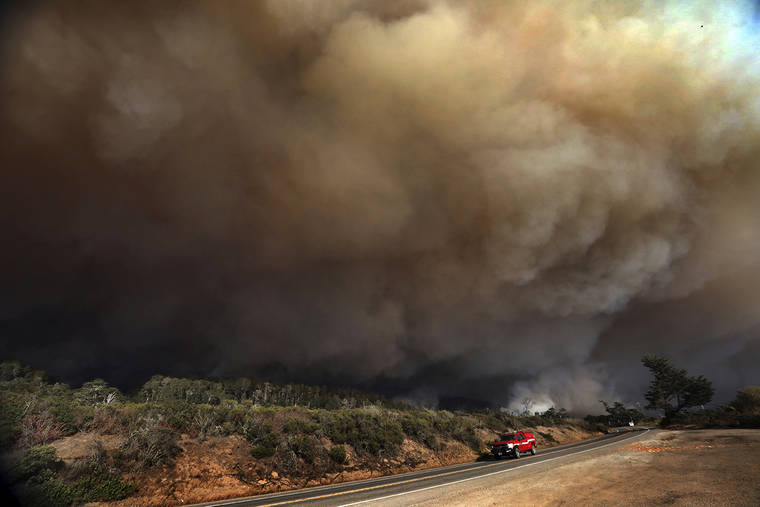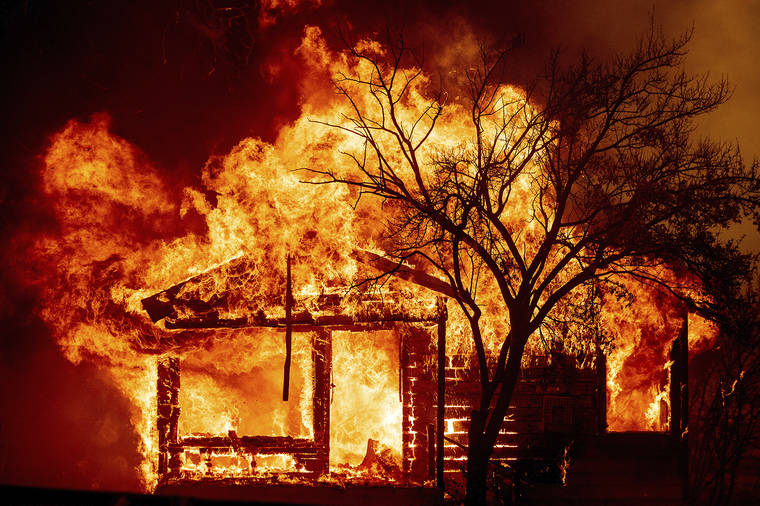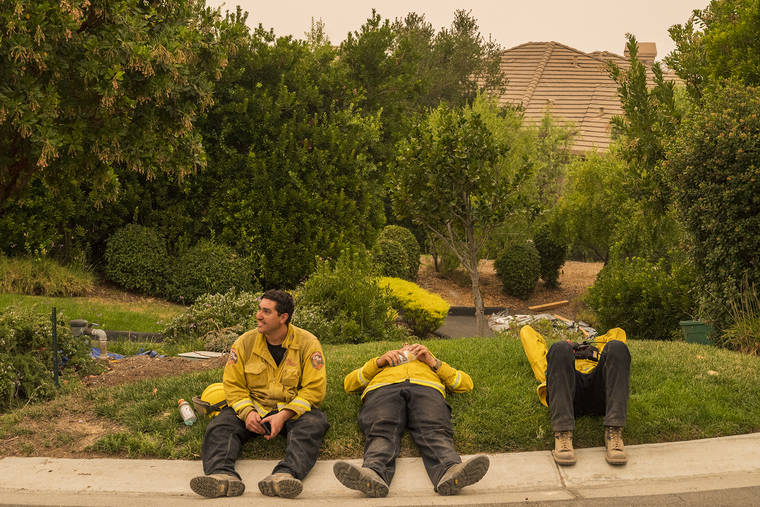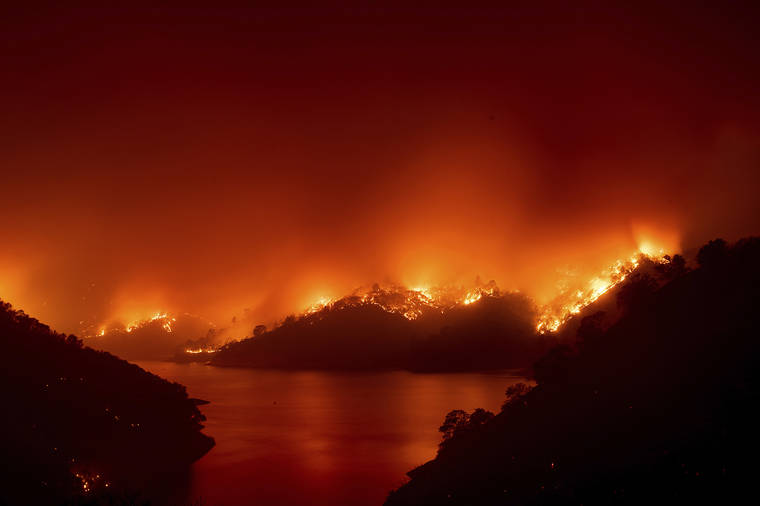California firefighters `taxed to the limit’ seeking help

A massive column of smoke rises above Highway 1 just north of the Santa Cruz County line as a section of the CZU August Lightning Complex burns above Waddell Beach, Wednesday Aug. 19, 2020, northwest of Santa Cruz, Calif. (Shmuel Thaler/The Santa Cruz Sentinel via AP)

Flames from the LNU Lightning Complex fires consume a home in Vacaville, Calif., Wednesday, Aug. 19, 2020. Fire crews across the region scrambled to contain dozens of wildfires sparked by lightning strikes as a statewide heat wave continues. (AP Photo/Noah Berger)

A CalFire crew from Coulterville takes a break while fighting the River Fire near Salinas, Calif., Wednesday, Aug. 19, 2020. (AP Photo/Nic Coury)

Flames from the LNU Lightning Complex fires burn around Lake Berryessa in unincorporated Napa County, Calif., on Wednesday, Aug. 19, 2020. Fire crews across the region scrambled to contain dozens of wildfires sparked by lightning strikes. (AP Photo/Noah Berger)
SANTA CRUZ, Calif. — More than two dozen major fires were scorching California on Thursday and taxing the state’s firefighting capacity, sparked by an unprecedented lightning siege that dropped nearly 11,000 strikes throughout several days.
SANTA CRUZ, Calif. — More than two dozen major fires were scorching California on Thursday and taxing the state’s firefighting capacity, sparked by an unprecedented lightning siege that dropped nearly 11,000 strikes throughout several days.
The fires had destroyed 175 structures, including homes, and were threatening 50,000 more as of Thursday afternoon, said Daniel Berlant, an assistant deputy director with the state Department of Forestry and Fire Protection. In all, 33 civilians and firefighters had been injured, and two people had died.
ADVERTISING
Most of the activity is in Northern California, where fires have chewed through about 500 square miles (1,250 square kilometers) of brushland, rural areas, canyon country and dense forest surrounding San Francisco.
More than 10,000 firefighters are on the front lines, but fire officials in charge of each of the major fire complexes say they are strapped for resources. Some firefighters were working 72-hour shifts instead of the usual 24 hours. The state has requested 375 engines and crew from other states.
“That’s going to allow our firefighters that have have been on the front line since this weekend to have an opportunity to take some rest,” Berlant said.
In Marin County, just north of San Francisco, where a smaller fire is burning near the Pacific Ocean, county fire chief Jason Weber said he is waiting for assistance from Montana to arrive this weekend.
He said in his 25 years in fire service, “we’ve never seen this level of draw-down” from cooperating agencies, as there is heavy competition in the western United States for equipment and people.
In the coastal mountain regions south of San Francisco, where 26,000 people were under orders to evacuate, the CZU complex fire grew overnight to 62 square miles (160 square kilometers). Officials warned it has the potential to grow significantly in the next day.
Given depleted resources, one of the best tools firefighters have for public safety is to get people out of harm’s way. But some people refused when officers went door-to-door Wednesday night, Cal Fire Chief Mark Brunton said.
“With the resources that we are lacking, we ask you to help us to help us to do our jobs and to keep the public safe,” he said.
Kevin Stover, 42, was struggling with indecision early Thursday when a mandatory evacuation order was issued for the rugged and small town of Felton outside the beach city of Santa Cruz.
“I don’t want to leave,” said Stover, a camera operator and rigger now driving for Door Dash and Lyft because of the pandemic. His car, loaded with important papers, his father’s urn and some arrowheads that meant a lot to him, had a flat tire.
“I’m trying to figure out if I should cut these original oil paintings out of the frame to salvage them,” he said.
The unusually large size and number of simultaneous fires, other fires throughout the West and the loss of inmate firefighting crews because inmates were released from prisons to prevent the spread of coronavirus, have created the perfect storm for firefighting.
“Our agency is taxed to the limit,” said Incident Commander Mike Smith at the fire near Santa Cruz. Officials there are awaiting help from other states, but they are having to look further afield than usual, meaning it will take days for crews to arrive, he said. The U.S. Forest Service can’t help because they are busy fighting fires on federal lands.
“This is a very dangerous fire. The probability of an ember igniting something is 100 percent, which is very high. Embers are traveling as far as mile and igniting trees and brush,” Smith said.
In addition to about two dozen major blazes, small fires kept erupting, though most were quickly stopped. Crews were also battling blazes in the Sierra Nevada and Southern California wild lands.
In Monterey County along the coast, about 9,000 people have been evacuated for a fire that’s now 52 square miles (136 square kilometers).
The fires have claimed two lives, including a Pacific Gas & Electric utility worker assisting with advance clearing who died at a fire in the Vacaville area between San Francisco and Sacramento. The worker was found Wednesday in a vehicle and CPR was performed, but he was pronounced dead at a hospital, Cal Fire said.
In central California, a pilot on a water-dropping mission in western Fresno County died Wednesday morning when his helicopter crashed.
Two fires in Sonoma County prompted evacuation orders for 8,000 residents near the Russian River Wednesday. Residents of Healdsburg, with a population of about 12,000, were warned Wednesday night to be ready to flee. Fires in that region destroyed more than 100 buildings, including some homes, and threatened 25,000 people across five counties.
Tim Edwards, president of the union representing 7,000 Cal Fire firefighters, said lawmakers need to allocate more money at a time when firefighters are working 40 to 50 days at a time without real relief.
“Here we are, we’re not even into our peak fire conditions, and we don’t have enough resources throughout the whole state because we’re stretched so thin,” he said.
Gov. Gavin Newsom, who pulled out of speaking at the Democratic National Convention Thursday, said that California received a federal grant to reimburse some of its firefighting costs.
Travis Air Force Base ordered non-mission-essential personnel to evacuate. Residents in nearby Vacaville, a city of 100,000, were roused before dawn Wednesday by orders to flee.
California State Parks announced full or partial closures of more than two dozen parks, including Big Basin Redwoods in the Santa Cruz Mountains, where the park headquarters and other facilities were damaged. The park featuring towering stands of ancient coast redwoods dates to 1902 and is the state’s oldest.
In Southern California, firefighters worked in high heat to increase containment of fires in mountains north and east of Los Angeles. A huge fire also burned in the remote Mojave National Preserve.


